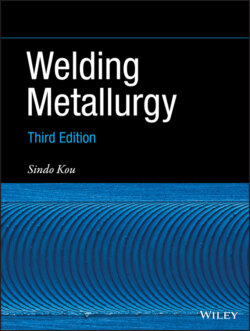Читать книгу Welding Metallurgy - Sindo Kou - Страница 44
1.4 High‐Energy‐Beam Welding 1.4.1 Electron Beam Welding 1.4.1.1 The Process
ОглавлениеEBW is a process that melts and joins metals by heating them with an electron beam. Arata [15] was a pioneer in high‐energy‐beam welding processes such as electron‐ and laser‐beam welding. As shown in Figure 1.26a, the cathode of the electron beam gun is a negatively charged filament. When heated up to its thermionic emission temperature, this filament emits electrons. These electrons are accelerated by the electric field between a negatively charged bias electrode (located slightly below the cathode) and the anode. They pass through the hole in the anode and are focused by an electromagnetic coil to a point at the workpiece surface. The beam current and the accelerating voltage employed for typical EBW vary over the ranges of 50–1000 mA and 30–175 kV, respectively. An electron beam of very high intensity can vaporize the metal and form a vapor hole during welding, that is, a keyhole, as illustrated in Figure 1.26b.
Figure 1.26 Electron beam welding: (a) process; (b) keyhole.
Figure 1.27 shows that the beam diameter decreases with decreasing ambient pressure [1]. Electrons are scattered when they hit air molecules, and the lower the ambient pressure, the less they are scattered. This is the main reason for EBW in a vacuum chamber.
Figure 1.27 Dispersion of electron beam at various ambient pressures [1].
Source: Welding Handbook, Vol. 3, 7th Edition, © American Welding Society.
The electron beam can be focused to diameters in the range of 0.3–0.8 mm and the resulting power density can be as high as 1010 W/m2 [1]. The very high‐power density makes it possible to vaporize the material and produce a deep‐penetrating keyhole and hence weld. Figure 1.28 shows a single‐pass electron beam weld and a dual‐pass gas–tungsten arc weld in a 13‐mm‐thick (0.5‐in.) 2219 Al, the former being much narrower [16]. The energy required per unit length of the weld is much lower in the electron beam weld (1.5 kJ/cm or 3.8 kJ/in.) than in the gas–tungsten arc weld (22.7 kJ/cm or 57.6 kJ/in.).
Figure 1.28 Welds in 13‐mm‐thick 2219 aluminum: (a) electron beam weld; (b) gas–tungsten arc weld. Source: Farrell [16].
Under high welding speeds, weld porosity results when gas bubbles do not have enough time to escape from the deep weld pool. Materials containing high‐vapor‐pressure constituents, such as Pb‐containing alloys, are not recommended for EBW because evaporation of these constituents tends to foul the pumps or contaminate the vacuum system.
